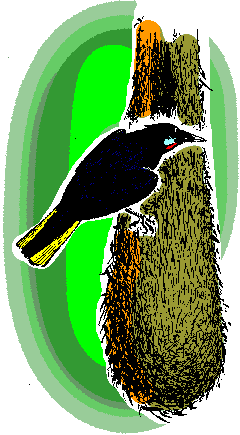COUNTRYSIDE AROUND
THE RUINS OF PALENQUE
On the US's
Thanksgiving Day, the rain holds off long enough for me to walk along the road between
town and the ruins, making the following list:
| November 28:
latitude 17º30'N, longitude 92º02'W MEXICO: Chiapas; along road, around ranchos
and trees of Maya Bell Campground, and just below ruins of Palenque
RESIDENCY STATUS:
winter resident
not found in the USA |
- Black Vulture
- Turkey Vulture
- Gray Hawk
- Roadside Hawk
- Short-tailed Hawk
- Plain Chachalaca
- Cattle Egret
- Squirrel Cuckoo
- Groove-billed Ani
- Long-tailed Hermit
- Rufous-tailed Hummingbird
- Aztec Parakeet
- White-fronted Parrot
- Golden-fronted Woodpecker
- Golden-olive Woodpecker
- Great Kiskadee
- Masked Tityra
- Montezuma Oropendola
- Brown Jay
- Blue-gray Gnatcatcher
- Clay-colored Robin
- Bananaquit
- Black-and-white Warbler
- Kentucky Warbler
- Magnolia Warbler
- Orange-crowned Warbler
- Yellow Warbler
- Common Yellowthroat
- Gray-crowned Yellowthroat
- Northern Parula
- American Redstart
- Melodious Blackbird
- Montezuma Oropendola
- Great-tailed Grackle
- Orchard Oriole
- Yellow-tailed Oriole
- Blue-gray Tanager
- Masked Tanager
- Scarlet-rumped Tanager
- Yellow-throated Euphonia
- Blue-black Grassquit
- White-collared Seedeater
- Black-headed Saltator
|
Noteworthy is the real abundance of Wilson's
Warblers, with American Redstarts and Magnolia Warblers being very common as well. Even
when it's raining these species busily forage among the bushes and trees. What a treat to
see the redstart so busy de-bugging a big, deeply palmately lobed cecropia leaf,
a kind of leaf very unlike anything the bird sees during the nesting phase of its life up
North.
 One of the
most spectacular birds in the list is also one of the most "jungly sounding"
ones, a fairly large bird (the male being about 20 inches long -- 50 cm), the Montezuma
Oropendola shown at the right. My Peterson field guide describes its bubbly,
haunting song as being "like water pouring out of a bottle: 5-7 liquid glub's
or gloob's, getting higher and faster." The one in my drawing is hanging on
its nest, so you might guess that oropendolas are closely related to orioles who build
similar pendulous nests. Sometimes you see large, isolated trees in pastures in which
several such large nests are hanging, and it's quite a sight. Despite the bird being so
spectacular, it's somewhat commonly encountered.
One of the
most spectacular birds in the list is also one of the most "jungly sounding"
ones, a fairly large bird (the male being about 20 inches long -- 50 cm), the Montezuma
Oropendola shown at the right. My Peterson field guide describes its bubbly,
haunting song as being "like water pouring out of a bottle: 5-7 liquid glub's
or gloob's, getting higher and faster." The one in my drawing is hanging on
its nest, so you might guess that oropendolas are closely related to orioles who build
similar pendulous nests. Sometimes you see large, isolated trees in pastures in which
several such large nests are hanging, and it's quite a sight. Despite the bird being so
spectacular, it's somewhat commonly encountered.
One Magnolia Warbler becomes famous in the
campground for attacking its reflection again and again in the side mirror of a pickup
truck from Maryland. This goes on the whole morning except for a five-minute period when a
Great Kiskadee comes driving the warbler away so he can attack his own
image in the same mirror. Several mirrors are available in this campground so one wonders
what is so special about this one.
 One of the
most spectacular birds in the list is also one of the most "jungly sounding"
ones, a fairly large bird (the male being about 20 inches long -- 50 cm), the Montezuma
Oropendola shown at the right. My Peterson field guide describes its bubbly,
haunting song as being "like water pouring out of a bottle: 5-7 liquid glub's
or gloob's, getting higher and faster." The one in my drawing is hanging on
its nest, so you might guess that oropendolas are closely related to orioles who build
similar pendulous nests. Sometimes you see large, isolated trees in pastures in which
several such large nests are hanging, and it's quite a sight. Despite the bird being so
spectacular, it's somewhat commonly encountered.
One of the
most spectacular birds in the list is also one of the most "jungly sounding"
ones, a fairly large bird (the male being about 20 inches long -- 50 cm), the Montezuma
Oropendola shown at the right. My Peterson field guide describes its bubbly,
haunting song as being "like water pouring out of a bottle: 5-7 liquid glub's
or gloob's, getting higher and faster." The one in my drawing is hanging on
its nest, so you might guess that oropendolas are closely related to orioles who build
similar pendulous nests. Sometimes you see large, isolated trees in pastures in which
several such large nests are hanging, and it's quite a sight. Despite the bird being so
spectacular, it's somewhat commonly encountered.